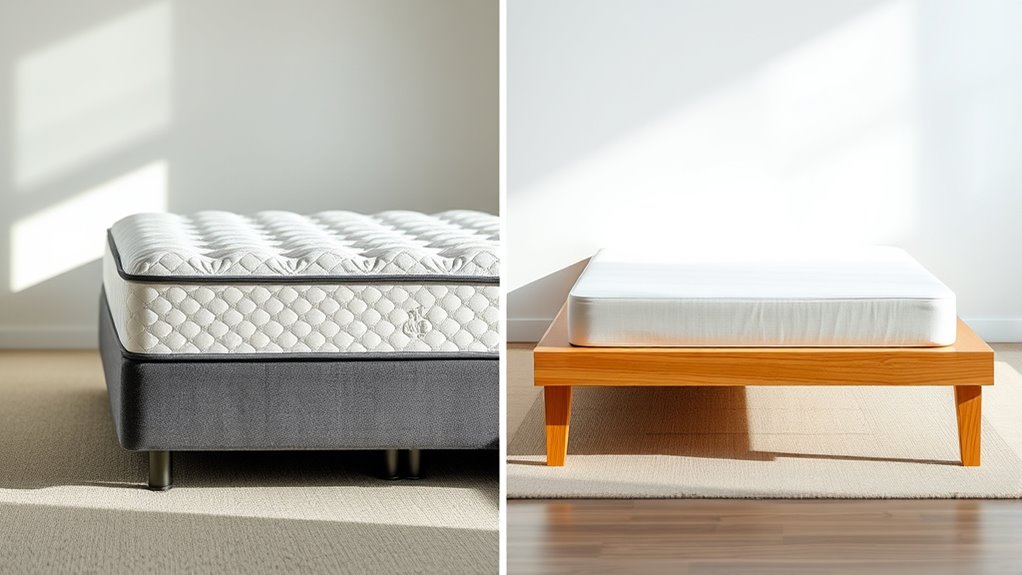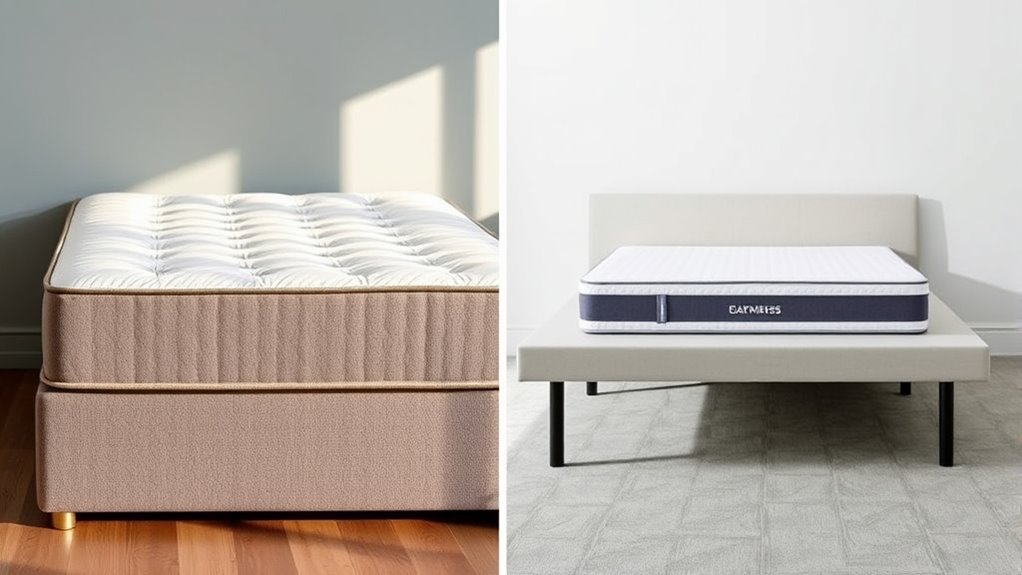A box spring is a supported foundation with a wooden frame and springs inside that lifts your mattress, adding height and bounce, mostly suited for traditional and innerspring beds. A platform bed, on the other hand, has a solid or slatted base that supports your mattress directly, offering a modern, lower profile ideal for memory foam or latex mattresses. Knowing the differences helps you choose the right support for comfort, style, and mattress longevity. Keep exploring for more details.
Key Takeaways
- A box spring is a traditional support with springs inside, raising the mattress height, while a platform bed has a solid or slatted base supporting the mattress directly.
- Box springs provide shock absorption and bounce, especially for innerspring mattresses; platform beds offer a firm, stable surface ideal for foam or latex mattresses.
- Box springs generally increase bed height and suit classic decor; platform beds have a lower profile with a modern, sleek appearance.
- Box springs are compatible with most mattress types and extend mattress lifespan; platform beds offer a flat, supportive surface that prevents sagging.
- The choice affects bedroom style, accessibility, and mattress support, with box springs adding height and traditional appeal, and platform beds providing a minimalist look.

When choosing a bed frame, understanding the difference between a box spring and a platform bed is essential, as each offers distinct support and style options. Your choice impacts how well your mattress performs and how your bedroom looks. A box spring is a traditional option that provides mattress support by acting as a shock absorber, absorbing impact and offering a slight bounce. It typically consists of a wooden frame covered with fabric and springs inside. The main purpose is to elevate the mattress and improve airflow, which can extend its lifespan. Box springs are compatible with most bed frame styles, especially those designed for traditional beds, and they often enhance the overall height of your bed, making it easier to get in and out of bed.
Platform beds, on the other hand, eliminate the need for a box spring altogether. They feature a solid or slatted base that provides direct support to the mattress. This design offers a firm, stable surface, which many people find preferable for their comfort and support needs. Because platform beds support the mattress directly, they tend to give a more modern, sleek look and come in a variety of styles—from minimalist to more ornate frames. This flexibility in bed frame styles helps you match your bedroom decor more easily. Plus, since there’s no box spring, the overall height of the bed is usually lower, giving your room a more contemporary feel.
Your choice between the two also affects your mattress support. Box springs can add a bit of bounce, which some people find beneficial for certain types of mattresses, like innerspring models. Conversely, platform beds generally provide a firmer support, which is ideal for memory foam or latex mattresses that require a stable, flat surface for optimal comfort and longevity. Choosing the right support system will help you avoid issues like sagging or uneven wear, ultimately prolonging the life of your mattress.
Choosing the right support prevents sagging and extends your mattress’s lifespan.
In addition to support considerations, your preferred bed frame styles may influence your decision. If you favor classic, traditional looks, a box spring paired with a suitable frame might be your best option. If you’re into modern, minimalist designs, a platform bed’s clean lines and low profile will likely appeal more. Both options are available in various materials, finishes, and designs, so you can find something that matches your aesthetic preferences while ensuring your mattress gets the proper support. Ultimately, understanding how each supports your mattress and complements your style will help you select the best bed frame for your bedroom.
Frequently Asked Questions
Which Is More Affordable, a Box Spring or a Platform Bed?
When comparing cost, a platform bed is generally more affordable than a box spring. You’ll find lower purchase prices, and installation costs are minimal since you don’t need a separate foundation. A box spring can be pricier due to its additional components and setup expenses. Overall, if you’re looking to save money, a platform bed offers a cost-effective solution with simpler installation, making it the better choice financially.
Can I Use a Box Spring With a Platform Bed?
Think of your bed setup like building a sandwich—you want all the layers to work together. Usually, you can’t use a box spring with a platform bed because they serve similar purposes—support and height. Most platform beds are designed for mattress compatibility without a box spring, offering better support on their own. So, mixing them might cause instability or damage, limiting your bed frame options and comfort.
Are Platform Beds Suitable for All Mattress Types?
You might wonder if a platform bed suits all mattress types. The good news is, platform beds are highly versatile and compatible with most mattress options, including memory foam, latex, and hybrid mattresses. They provide sturdy support without needing a box spring, making them a popular bed frame choice. Just make sure your mattress size matches the platform’s dimensions for the best mattress compatibility and peak support.
How Long Does a Typical Box Spring Last?
You might worry about how long a box spring lasts, but with proper care, it can serve you well. Typically, a box spring lasts about 8 to 10 years, depending on mattress durability and usage. Keep in mind that spring lifespan varies based on weight and wear. Regularly inspect for sagging or damage, and rotating your mattress helps extend the box spring’s life, ensuring continued support and comfort.
Do Platform Beds Require a Box Spring for Height?
You don’t need a box spring for a platform bed since it already provides the bed height and support. Platform beds are designed to work directly with most mattress types, ensuring mattress compatibility. This setup offers a lower profile, which many prefer for a modern look. Plus, eliminating the box spring simplifies your bedding setup and reduces costs while maintaining proper support and comfort.
Conclusion
Understanding the difference between a box spring and a platform bed helps you select the right support for your mattress. For instance, imagine upgrading your bedroom with a sleek platform bed—you’ll enjoy a modern look and solid support without the need for a box spring. Whether you prefer classic or contemporary styles, knowing your options guarantees you get a comfortable, durable setup that suits your lifestyle and enhances your sleep quality.









